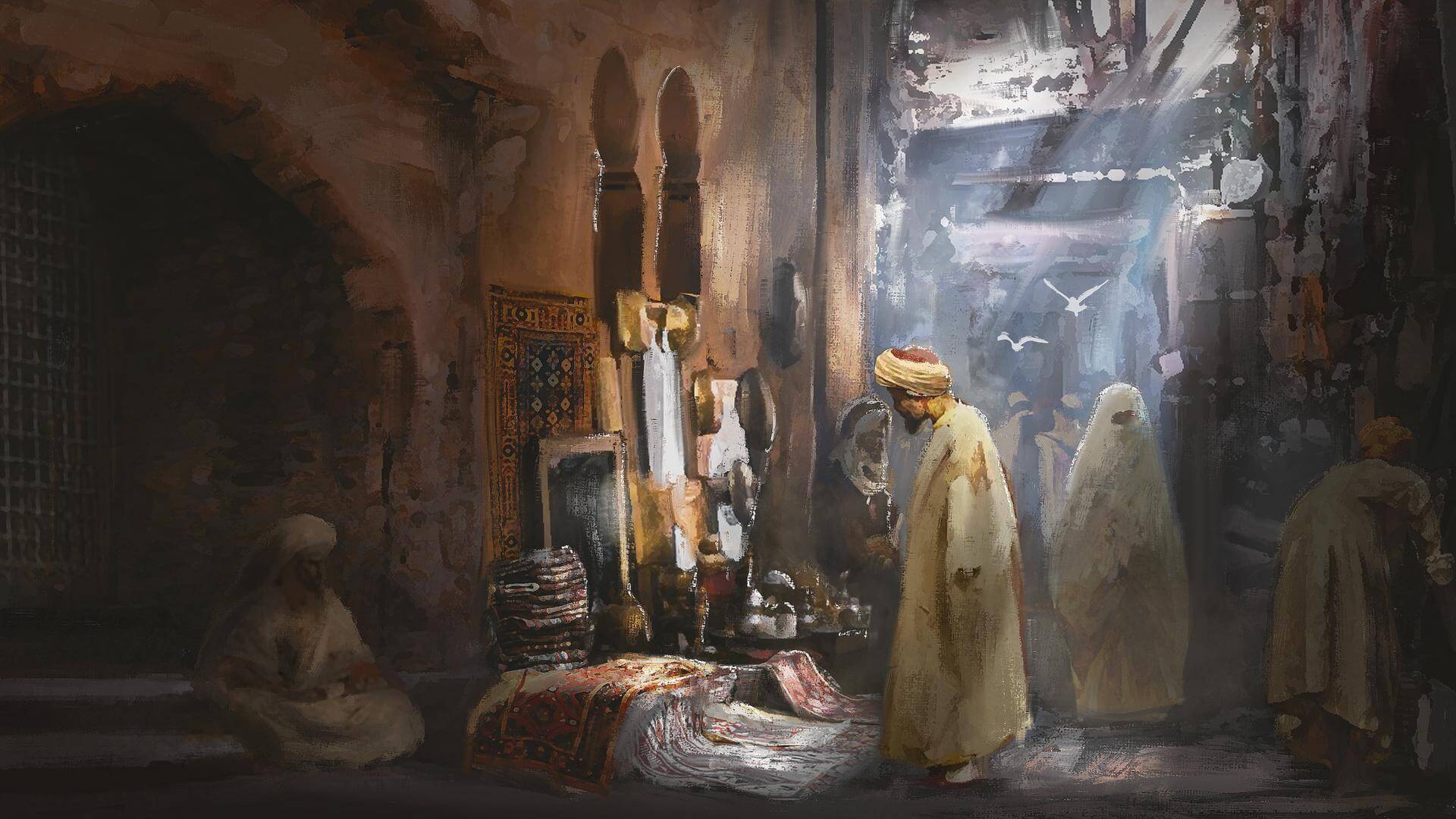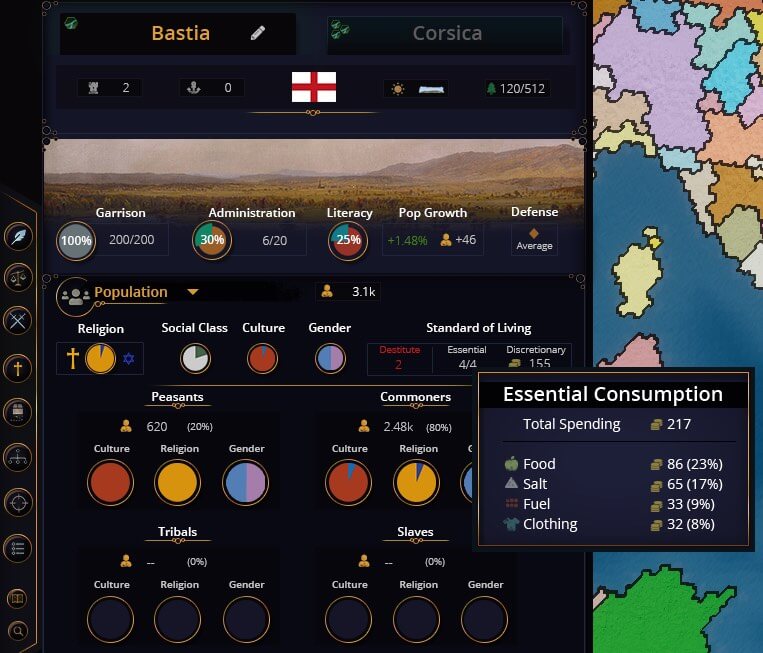Dev Diary #14: Consumption
16:13, 3 Sep 2022

Hello and welcome to the 14th development diary of Grey Eminence!
Today, we’re continuing the series of dev diaries dedicated to the economy with consumption. As with the production system we covered last week, consumption is a core element of Grey Eminence’s economy: after all, buildings ultimately exist to produce goods to satisfy your population’s needs. We’ve designed the consumption system with optional complexity in mind, so if you’re not a fan of micromanaging your economy, you won’t be forced to interact with consumption (unless the situation gets particularly dire).
To give you a general overview of how consumption works: every social class in every tile has specific essential and discretionary needs that it tries to satisfy. The social classes use whatever wealth is available to them - usually their income from wages and their savings - to buy goods and services from their local market (but more on trade and employment another time). The level to which these needs are satisfied determines the standard of living for that social class, which serves as a straightforward barometer for how well the population is doing.
Essential Needs
The top priority for every social class is to fulfill its essential needs. This includes the goods that are necessary for leading a normal life: obviously food, but also things like fuel (for heating and cooking), clothing, and salt (for food preservation). Each need is always for a specific quantity of goods and, importantly, it can be satisfied by any goods that fall into these respective categories. In other words, a starving peasant won’t be picky about whether he gets to eat 1 unit of fish or grains to stave off starvation. Similarly, multiple goods can be used as fuel: wood is the classic example in use throughout the world in 1356 alongside coal, with more advanced fuels like oil becoming available later on as the game progresses.
Since essential needs are, well, essential, the social classes will be prepared to pay any price to fulfill them. Thus, whenever there are shortages of essential goods, you’ll see large spikes in their price (which are usually, but not always, balanced out via trade) and of course an accompanying jump in the profits of whoever owns the industries producing these goods. In general, essential goods shortages are much more prevalent in the first half of the game, when production is inefficient and surplus margins are razor thin (which also puts a natural cap on the size of the non-essential industries, but we don’t want to get too deep into the economics just yet).
Discretionary Needs
Once a social class has purchased whatever goods it needs to survive, it now gets to spend whatever it has left (if anything) on goods that are not quite so vital. Discretionary needs usually make up the majority of consumption for most non-starving social classes. Unlike essentials, which are always a fixed amount of demand, discretionary needs are open-ended. Each social class will try to allocate a percentage of its leftover funds to all available consumer goods (modified by various cultural, religious, and societal factors), thus ensuring there is always demand for these goods. Notably, goods that are considered essential can also be present in the discretionary section: for example, commoners who mostly eat grains will still try to splurge on other, rarer foods like meat or fruits. This process is repeated until the social classes either run out of money to spend or goods to buy (an extremely unlikely occurrence).
There is one intermediate step that we didn’t mention between essential and discretionary consumption: if a social class has any leftover funds after buying its essentials, it will deposit some of them into its tile as savings. We’ll discuss savings and the credit economy in a separate dev diary, but we felt now is a good time to mention that we’re planning such a feature.
Standard of Living
Tallying up the essential and discretionary consumption of a given social class provides us with a more-or-less objective rating of its standard of living. This value can range from 0 to 10 and it is intended to serve as a quick barometer for how well the population is doing. Since essential consumption is always a fixed-size amount of demand, fulfilling just that cannot raise the SoL beyond (numbers subject to change) 1. Beyond that, increasing SoL will require an ever-larger amount of discretionary consumption, with 10 representing utopian opulence that would be unrealistic to achieve for any decently-sized country until the very end of the game.
Having a SoL below 1 (i.e. having unfulfilled essential needs) causes large amounts of discontent, which - if left unchecked - can escalate into rebellions (and even revolutions, but more on that another time). If you’re particularly cold-hearted, letting hunger metastasize into rebellion is one way of resolving essential goods shortages: after all, dead rebels don’t need food. For a more reasonable solution, you can try fixing the situation via trade or building/sponsoring construction of the industries in demand.
Having a falling SoL will also cause some discontent, so it’s usually not a good idea to overshoot too much via temporary measures like cutting taxes or subsidizing industry unless you can maintain these expenditures. While failing to meet your people’s unrealistic expectations will rarely lead to rebellion on its own, it might just prove to be the straw that broke the camel’s back if there are other societal issues festering in your country.

The people of Corsica live a decent, if not particularly rich life. They’re not starving, have clothes on their back and enough fuel to survive the winter, so they can’t complain.
Moddability
As always, we’ve designed the consumption system with moddability in mind. We’re proud to say that we’ve achieved a very low level of hardcodedness, especially on linking consumption to other systems. To give you several examples of what you can do: consumption tables (the list of goods and quantities a particular social class wants to buy) is configurable and can be changed during the course of the game. We’ve opted to keep it static in the base game, but you needn’t follow our decision for your mods. You can link the consumption of particular goods to other mechanics; for example, a certain good might increase the population’s birth rate or make them more prone to discontent. If you’re interested in more fine-tuned measures of consumption, the standard of living layer can be stripped away entirely with minimal consequences. We’ve put in the effort to make consumption moddable since we feel it’ll be an important tool for making fantasy worlds come alive (mana as a trade good, anyone?), but of course it’ll be useful for all sorts of alternate history settings too. We look forward to seeing all the creative ways you’ll put this system to use!
That’s all for today, thanks for reading! We’re making consistent and steady progress on the game; while our development pace has slowed down, we remain committed to finishing Grey Eminence and releasing it in a polished state, so thank you for the patience and support in these trying times. Stay tuned for the next dev diary on October 1 and don’t forget to join our Discord and Subreddit, and to follow us on YouTube, Facebook, and Twitter.


 Back
Back